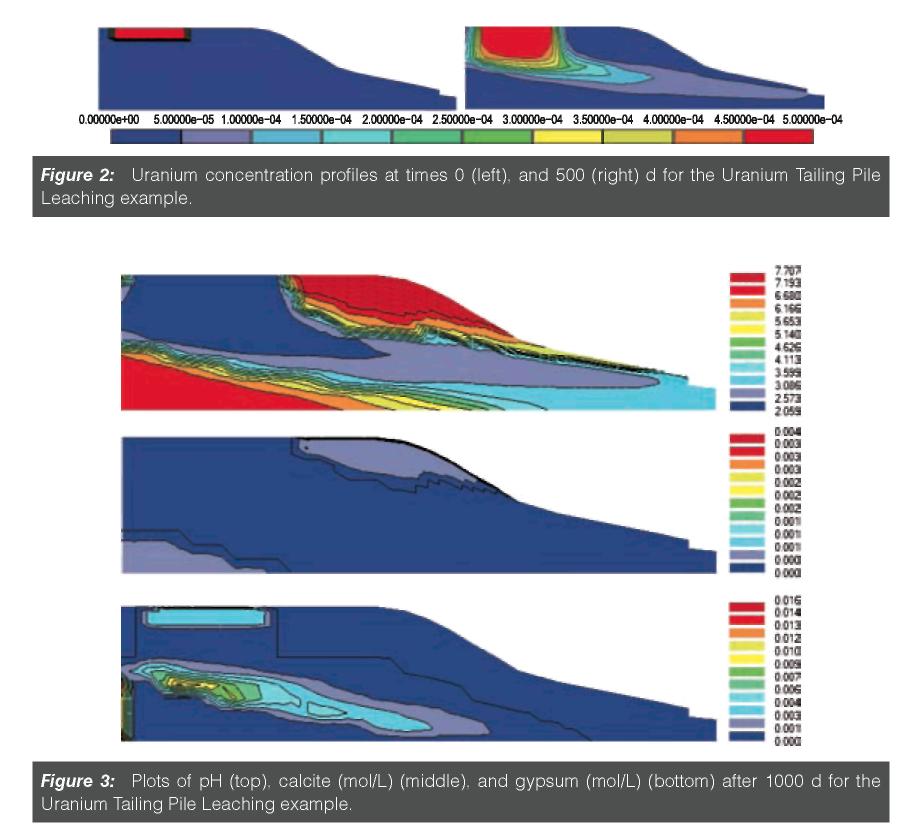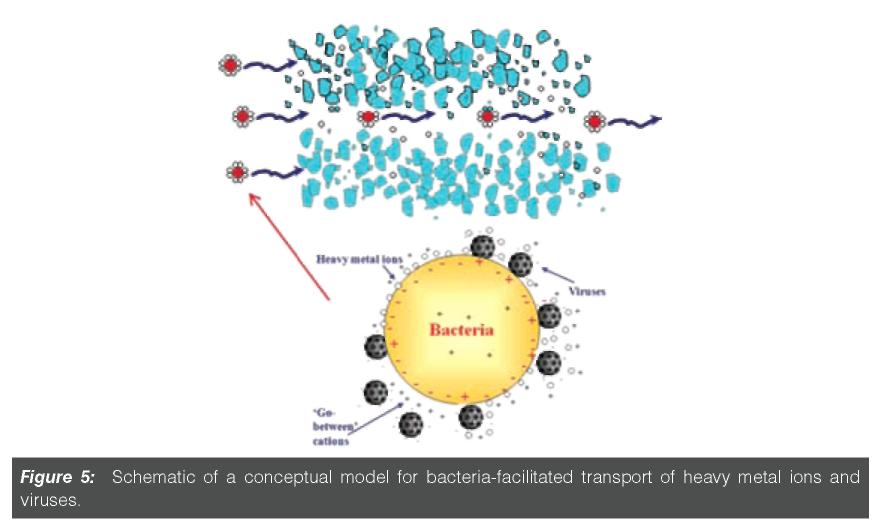
- •1 Вступ
- •2 Пакети програмного забезпечення hydrus
- •3 Переміщення розчинів
- •3.1 Переміщення поодиноких іонів
- •3.2 Transport of multiple ions subject to sequential frst-order decay reactions
- •3.3 Transport of mutually dependent multiple ions
- •4 Specialized hydrus Modules
- •4.1 The hp1/hp2 modules
- •4.3 The DualPerm module
- •4.4 The UnsatChem module
- •4.5 The Wetland module
- •4.6 The Fumigants module
- •5 Conclusions
4 Specialized hydrus Modules
In this section we summarize several newly implemented HYDRUS modules, some of which represent examples of reactive transport with specifc chemistry (notably the Wetland and UnsatChem modules), while others consider general reactive transport (the HP1 and HP2 models). Also briefy discussed are several modules not intended for the transport of multiple solutes but providing additional modeling capabilities, such as to account for preferential fow (the DualPerm module), colloid-facilitated solute transport (the C-Ride module), or fumigant transport (the Fumigant module). Except for the older HP1, all modules simulate fow and transport processes in two-dimensional transport domains and are fully supported by the HYDRUS (2D/3D) graphical user interface.
Many of the processes are also available as part of HYDRUS-1D.
4.1 The hp1/hp2 modules
The one-dimensional program HP1, which couples the PHREEQC geochemical code73 with HYDRUS-1D, was frst released in 2005,16 and used successfully in many applications. HP1, which is an acronym for HYDRUS-PHREEQC-1D, is a relatively comprehensive simulation module that can be used to simulate (1) transient water fow, (2) the transport of multiple components, (3) mixed equilibrium/kinetic biogeochemical reactions, and (4) heat transport in one-dimensional variably-saturated porous media. HP279 is the two-dimensional equivalent of HP1. The HP1 and HP2 modules both can simulate a broad range of low-temperature biogeochemical reactions in water, the vadose zone and/or ground water systems, including interactions with minerals, gases, exchangers and sorption surfaces based on thermodynamic equilibrium, kinetic, or mixed equilibrium-kinetic reactions.
The versatility of HP1 was demonstrated by Jacques and Šimu˚nek16 and Jacques et al.5,7 on several examples, including (a) the transport of heavy metals (Zn2+, Pb2+, and Cd2+) subject to multiple cation exchange reactions, (b) transport with mineral dissolution of amorphous SiO2 and gibbsite (Al(OH)3), (c) heavy metal transport in a medium having a pH-dependent cation exchange complex, (d) infltration of a hyperalkaline solution in a clay sample (this example considered kinetic precipitation-dissolution of kaolinite, illite, quartz, calcite, dolomite, gypsum, hydrotal-cite, and sepiolite), (e) long-term transient fow and transport of major cations (Na+, K+, Ca2+, and Mg2+) and heavy metals (Cd2+, Zn2+, and Pb2+) in a soil profle, (f) cadmium leaching in acid sandy soils, (g) radionuclide transport, and (h) long term uranium migration in agricultural feld soils following mineral P-fertilization.
More recent applications of HP1 include Bessinger and Marks,85 who used HP1 to evaluate laboratory and feld experiments involving the treatment of mercury-contaminated soils with activated carbon, and Jacques et al.86,87 who used HP1 to model chemical degradation of concrete during leaching with rain and different types of water. Jacques et al.87 also considered the effects of chemically degrading concrete on its hydraulic properties such as porosity, tortuosity, and the hydraulic conductivity. Jacques et al.88 additionally combined HP1 with the general optimization UCODE program89 to inversely optimize hydraulic, solute transport, and cation exchange
parameters pertaining to column experiments subject to transient water fow and solute transport with cation exchange.
The versatility of HP2 was demonstrated recently by Šimu˚nek et al.79 on several examples: (a) a sodic soil reclamation problem using furrow irrigation, which demonstrated the cation exchange features of HP2, and (b) the release and migration of uranium from a simplifed uranium mill tailings pile towards a river. These examples included the processes of water fow, solute transport, precipitation/dissolution of the solid phase, cation exchange, complexation, and many other reactions. As an example of possible modeling output, Figures 2 and 3 show uranium concentration profles at two different times, and fnal pH, calcite, and gypsum profles, respectively, for the uranium tailings example adapted from Yeh and Tripathi.90 Detailed information about this project, as well as instructions on how to implement the project using HP2, can be found in Šimu˚nek et al.79
4.2 The C-Ride module
The C-Ride module91 considers the transport of particle-like substances (e.g., colloids, microorganisms, and nanoparticles) as well as colloid-facilitated transport,30 the latter often observed for many strongly sorbing contaminants such as heavy metals, radionuclides, pharmaceuticals, pesticides, and explosives. These contaminants are associated predominantly with the solid phase, which is commonly assumed to be stationary. However, the contaminants may also sorb/attach to mobile and deposited colloidal particles (e.g., microbes, humic substances, suspended clay particles, and metal oxides), which then can act as pollutant carriers and thus provide a rapid transport pathway for the pollutants.
The C-Ride module fully accounts for the dynamics of colloid transfer (attachment/straining) and solute transfer (kinetic/equilibrium sorption onto soil and mobile/deposited colloids) between the different phases. A schematic of the colloid transport and colloid-facilitated transport module is shown

in Figure 4. The module assumes that the porous medium consists of three phases (i.e., solid, air and water). Following van der Weerd and Leijnse,92 the C-Ride module assumes that (a) only one type of colloid exists in the system, and that the colloids can be described by their mean behavior, (b) colloids are stable and that their mutual interactions in the liquid phase may be neglected, (c) immobile colloids do not affect the fow and transport properties of the porous medium because of possible clogging of small pores, and (d) the transport of colloids is not affected by sorption of contaminants on colloids. Colloids are assumed to exist in three states (Fig. 4, top): mobile (suspended in water), Cc [NcL-3], attached to the solid phase, Scatt [NcM-1], and strained by the solid phase, Scstr [NcM-1]. Colloid phase changes are described in terms of nonlinear frst-order processes of attachment, kac [T-1], detachment, kdc [T-1], and straining, kstr [T-1].
C-Ride further assumes that contaminants can be dissolved in the liquid phase, C [ML-3], as well as can be sorbed instantaneously (Se [MM-1]) and kinetically (Sk [MM-1]) to the solid phase, and to colloids in all of their states (Smc, Sic [MNc-1]). Six different states of contaminants (Fig. 4, bottom) are thus distinguished: dissolved, instantaneously or kinetically sorbed to the solid phase, and sorbed to mobile or immobile colloids (the latter either strained or attached to the solid phase). The coeffcients kamc, kaic, kdmc, kdic [T-1] in Figure 4 represent various frst-order attachment/detachment rates to/from mobile and immobile colloids. The coeffcients Kd and ω represent instantaneous and kinetic solute sorption to the solid phase, respectively, while the factors ψ account for nonlinearity
of the various processes.30,91
Figure 5 shows a conceptual model for cadmium (and virus) transport facilitated by


B. subtilis spores or E. coli in saturated coarse alluvial gravels.96 This application of the C-Ride module successfully simulated Cd transport involving advec-tion, dispersion, kinetic adsorption-desorption of Cd to/from the aquifer and to/from mobile/immobile bacteria, and kinetic attachment/detachment of the bacteria to/from the aquifer.
